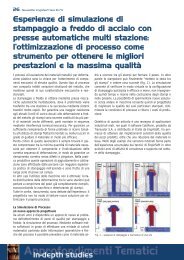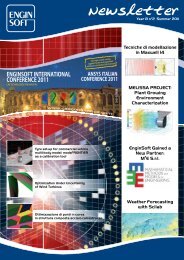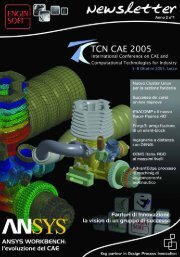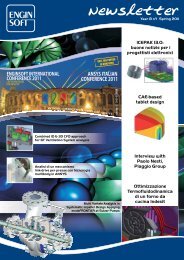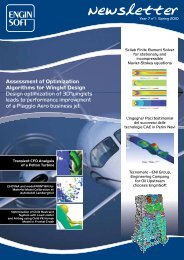software training courses 2010 corsi di addestramento ... - EnginSoft
software training courses 2010 corsi di addestramento ... - EnginSoft
software training courses 2010 corsi di addestramento ... - EnginSoft
You also want an ePaper? Increase the reach of your titles
YUMPU automatically turns print PDFs into web optimized ePapers that Google loves.
Newsletter <strong>EnginSoft</strong> Year 6 n°4 - 25<br />
Optimization in product development -<br />
An efficient approach to integrate single<br />
CAE Technologies up to the entire<br />
design chain<br />
Overview<br />
In today’s industrial production plants, state-of-the-art<br />
<strong>software</strong> systems are used to analyze <strong>di</strong>fferent loa<strong>di</strong>ng<br />
con<strong>di</strong>tions in order to determine the performance and<br />
durability of a product. Similarly, production companies<br />
use simulation for manufacturing processes, such as<br />
casting and wel<strong>di</strong>ng. Optimization techniques are widely<br />
regarded and applied as the next logical step to perfect<br />
competencies in simulation for modern product<br />
development. Possible applications of optimization<br />
techniques range from local problems with single<br />
applications up to the mapping and optimization of a<br />
large range of parameters of an entire product<br />
development process. Hence optimization can provide<br />
significant time and resources savings, opportunities that<br />
are illustrated in this article.<br />
Introduction<br />
Since the introduction of the computer, nearly all areas of<br />
life have changed rapidly. This applies also, and in<br />
particular, to the working environment and all professional<br />
activities of engineers.<br />
For example, engineering<br />
drawings are no longer<br />
made on a drawing board<br />
using 2D techniques; 3D<br />
models are created<br />
instead on the screen.<br />
Thus necessary<br />
adjustments to the<br />
product are realized<br />
quickly, for example the<br />
weight or the moment of<br />
inertia of complex<br />
Figure 1: Stress analysis of a crank shaft<br />
Figure 3 (a) Soli<strong>di</strong>fication stage of a casting simulation and (b) forging simulation of a crank shaft<br />
Picture 2: CFD simulations for a turbine blade<br />
geometries can be determined – all in an automated way.<br />
Advances in computational mechanics, such as the FEA<br />
Finite-Element Method, have also made their way into<br />
modern production facilities a long time ago. Again, clear<br />
advantages of simulation are shortened product<br />
development cycles, improved assessments of product<br />
quality and, importantly, savings in experimental time and<br />
equipment.<br />
Today’s status of simulation in product development<br />
covers a number of standard analyses, inclu<strong>di</strong>ng:<br />
Strength and durability/fatigue analyses of mechanical<br />
and/or thermally stressed devices in most <strong>di</strong>verse<br />
loa<strong>di</strong>ng con<strong>di</strong>tions (Figure 1),<br />
Computation of characteristic measures in CFD<br />
problems as shown in Figure 2,<br />
Crash Simulations in the area of Safety Engineering and



